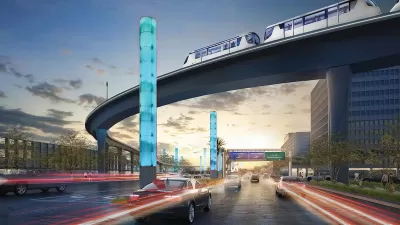Tuesday was a day of celebration in South L.A. as officials broke ground on the 8.5-mile Crenshaw Line, the newest addition to the region's expanding transit network. But just two days later, politicians resumed bickering over how to connect to LAX.
The Crenshaw Line, which will become "the first new rail service in a generation to traverse transit-dependent South Los Angeles" when it opens in 2019, is expected to cost $2.06 billion, with $700 million from federal grants and loans. Bending the line's route to the west would complete a "decades-long effort to bring rail service directly to Los Angeles International Airport." But with an estimated cost of an additional $3 billion, "transportation officials placed on the back burner a proposal for a light-rail tunnel under the terminal area," reports Laura J. Nelson. At a Los Angeles County Metropolitan Transportation Authority board meeting held on Thursday, board members made it clear they will focus on making the connection to LAX via a "people-mover" or circulator train.
"Barring a significant change, L.A. would soon have two light-rail routes that come near LAX but do not deliver passengers to their terminals, a problem that has puzzled and frustrated many civic leaders and transit users," adds Nelson. But some experts believe the people-mover option has its benefits.
"'If Metro knows they won't have the money to build light rail into the terminal area, and these people-mover options are a close substitute,' that choice may provide the public the biggest benefit," said Juan Matute, associate director of the UCLA Institute of Transportation Studies.
FULL STORY: Metro shelves direct rail line to LAX

Study: Maui’s Plan to Convert Vacation Rentals to Long-Term Housing Could Cause Nearly $1 Billion Economic Loss
The plan would reduce visitor accommodation by 25,% resulting in 1,900 jobs lost.

North Texas Transit Leaders Tout Benefits of TOD for Growing Region
At a summit focused on transit-oriented development, policymakers discussed how North Texas’ expanded light rail system can serve as a tool for economic growth.

Why Should We Subsidize Public Transportation?
Many public transit agencies face financial stress due to rising costs, declining fare revenue, and declining subsidies. Transit advocates must provide a strong business case for increasing public transit funding.

How to Make US Trains Faster
Changes to boarding platforms and a switch to electric trains could improve U.S. passenger rail service without the added cost of high-speed rail.

Columbia’s Revitalized ‘Loop’ Is a Hub for Local Entrepreneurs
A focus on small businesses is helping a commercial corridor in Columbia, Missouri thrive.

Invasive Insect Threatens Minnesota’s Ash Forests
The Emerald Ash Borer is a rapidly spreading invasive pest threatening Minnesota’s ash trees, and homeowners are encouraged to plant diverse replacement species, avoid moving ash firewood, and monitor for signs of infestation.
Urban Design for Planners 1: Software Tools
This six-course series explores essential urban design concepts using open source software and equips planners with the tools they need to participate fully in the urban design process.
Planning for Universal Design
Learn the tools for implementing Universal Design in planning regulations.
Ascent Environmental
Borough of Carlisle
Institute for Housing and Urban Development Studies (IHS)
City of Grandview
Harvard GSD Executive Education
Toledo-Lucas County Plan Commissions
Salt Lake City
NYU Wagner Graduate School of Public Service



























